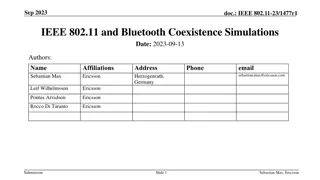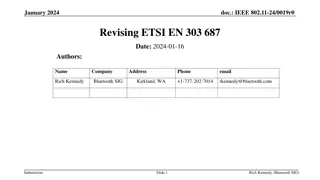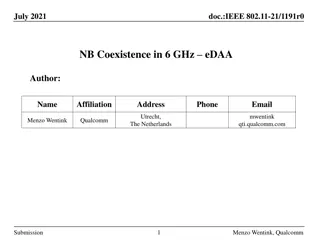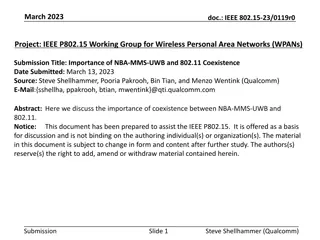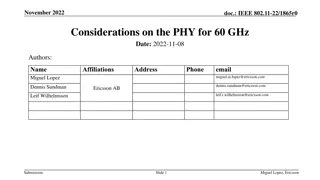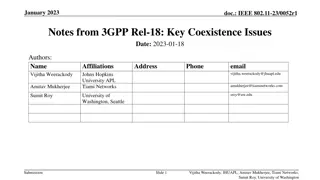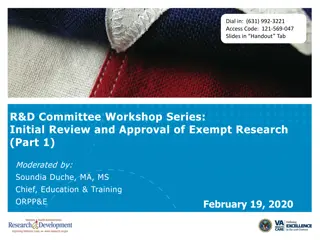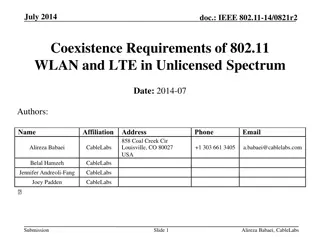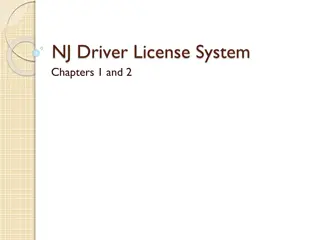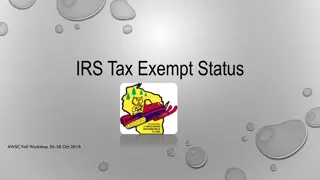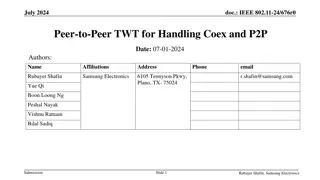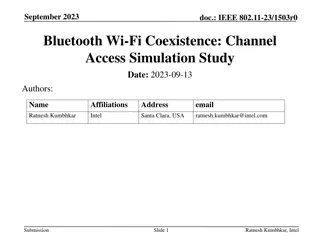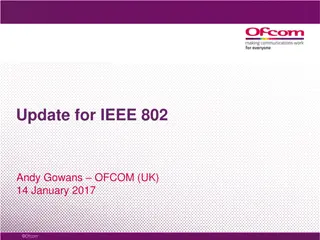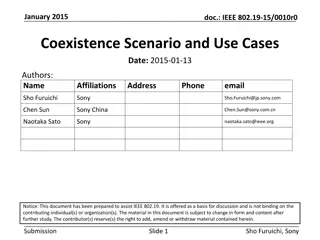Coexistence in 6 GHz License-Exempt Spectrum - IEEE 802.11-19/1083r1
This document discusses the principles and key features of unlicensed spectrum in the 6 GHz frequency band, focusing on coexistence with incumbent services, spectrum efficiency, and regulatory discussions. It also delves into channel access design for 3GPP technologies in the 5 GHz band, highlighting differences between managed and ad-hoc networks, performance factors, and coexistence considerations.
Uploaded on Aug 04, 2024 | 0 Views
Download Presentation

Please find below an Image/Link to download the presentation.
The content on the website is provided AS IS for your information and personal use only. It may not be sold, licensed, or shared on other websites without obtaining consent from the author. Download presentation by click this link. If you encounter any issues during the download, it is possible that the publisher has removed the file from their server.
E N D
Presentation Transcript
July 2019 doc.: IEEE 802.11-19/1083r1 Coexistence in 6 GHz License-exempt Spectrum Date: 2019-07-17 Authors: Name Sorour Falahati Affiliations Ericsson Address Phone email Guido Hiertz Ericsson Narendar Madhavan Ericsson Submission Slide 1 Sorour Falahati, Ericsson
July 2019 doc.: IEEE 802.11-19/1083r1 Unlicensed Spectrum - Principles Same carrier can be accessed by multiple networks or operators Networks and carriers can use different technologies Not limited only to IEEE and 3GPP technologies No restrictions on the operation mode of networks and devices Networks can be managed or ad-hoc IEEE networks are optimized for ad-hoc operation 3GPP networks are optimized for managed operation Submission Sorour Falahati, Ericsson
July 2019 doc.: IEEE 802.11-19/1083r1 Unlicensed spectrum in 6 GHz Key features No RLAN technologies already deployed Opportunity for enhancing spectrum efficiency by using modern technology neutral coexistence Coexistence with incumbent services is critical Needs some form of AFC (automatic frequency coordination) Discussions are ongoing in regulatory bodies on how this is to be achieved The range of spectrum made available for unlicensed operation is still under discussion 6.425 GHz to 7.125 GHz could be assigned as licensed spectrum in some regions 5.925 GHz to 6.425 GHz expected to be assigned as unlicensed spectrum in both US and Europe Submission Sorour Falahati, Ericsson
July 2019 doc.: IEEE 802.11-19/1083r1 3GPP Technologies Channel Access in 5 GHz Started from a clean slate with several fundamental aspects discussed LBT Protocol Load based vs. Frame based Frame based was an attractive choice due to frame structure of LTE LBT types: Random back-off with a contention window of fixed size (cat. 3 LBT) vs. variable size with exponential backoff (cat. 4 LBT) Cat. 3 LBT was better suited to the frame structure of LTE Slot size: 9 s vs. 20 s 20 s better suited for LTE with 1 ms subframes Contention window sizes: EDCA vs. other options Shorter contention window size very attractive for LTE UL and control Maximum Channel Occupancy Time (MCOT) Channel occupancy times aligned with ETSI BRAN harmonized standard Energy detection thresholds An absolute and calibrated ED threshold that is 10 dB lower than Wi-Fi Multi-carrier operation Wi-Fi channel bonding sets adopted for LTE UL Submission Sorour Falahati, Ericsson
July 2019 doc.: IEEE 802.11-19/1083r1 3GPP Technologies Channel Access in 5 GHz Remaining differences in channel access design are mainly due to one or more of the following Fundamental differences between a managed and an ad-hoc network LTE and NR UEs do not transmit any data on their own unless explicitly granted by a supervising node Performance considerations Complexity considerations Coexistence depends on sensing threshold, LBT protocol and transmit duration The most significant remaining difference between IEEE 802.11 and 3GPP technologies is the differing sensing thresholds used by 802.11 nodes to 802.11 and non-802.11 nodes IEEE 802.11 devices defer to 802.11 devices at a lower sensing threshold and all other devices at a higher sensing threshold LTE (and NR-U) devices defer to all devices at the same threshold Submission Sorour Falahati, Ericsson
July 2019 doc.: IEEE 802.11-19/1083r1 A Single Common Maximum Threshold A single common maximum energy detection threshold for all technologies Fundamentally fair coexistence: It enables all nodes to be respected at the same energy level regardless of which technology they use Superior performance: Allows fully flexible adaptation of the threshold used for each deployment Simple and robust compliance verification Flexible technology innovation Coexistence is decoupled from the use of technology specific signals: Each technology can independently develop preambles or other signals/protocols that provide benefits such as power saving, system performance improvements etc. without concerns on coexistence Additional sensing mechanisms for sharing within a network can be independently used as long as these mechanisms comply with the single common maximum energy detection threshold across all technologies. Examples: A network operating without scheduling can use preambles for sharing (e.g., IEEE 802.11a/n/ac/ax) A managed network can use scheduled operation for sharing (e.g., LTE, NR, IEEE 802.11ax) Submission Sorour Falahati, Ericsson
July 2019 doc.: IEEE 802.11-19/1083r1 3GPP Technologies Channel Access in 5 GHz For 3GPP technologies, a single ED threshold of 72 dBm/20 MHz was chosen to be in between the ED and PD thresholds for IEEE 802.11 devices to enable a long term convergence for all technologies, including 802.11ax, to this single harmonized threshold IEEE 802.11ac was an already deployed technology at the time LTE-LAA was developed but harmonization with 802.11ax was considered a possibility Adoption of ED at 72 dBm/MHz for all technologies in 5 GHz, including IEEE 802.11ax, was part of an ETSI TC BRAN agreement. This agreement and associated discussions are documented in [2 6]. 3GPP RAN1 requested IEEE 802.11 to adopt an aligned ED threshold of 72 dBm. IEEE 802.11 declined this request and explained it as follows [1]: IEEE 802 declined 3GPP RAN1 s request because it would put 802.11ax systems at a disadvantage compared to billions of existing and future 802.11a/n/ac systems using an ED threshold of 62 dBm and at a disadvantage to any LAA systems not detecting 802.11 preambles at 82 dBm. Submission Sorour Falahati, Ericsson
July 2019 doc.: IEEE 802.11-19/1083r1 Coexistence in 6 GHz Unlicensed spectrum in 6 GHz does not have any already deployed RLAN devices preventing the adoption of a single threshold No issue with existing IEEE 802.11n/ac devices that use a higher ED threshold => ED threshold can be reduced to 72 dBm (or some other value common to all nodes, networks and technologies) Preamble detection threshold can optionally be raised to 72 dBm at least for other IEEE 802.11ax networks (no legacy 80211n/ac devices) The 6 GHz band provides an excellent opportunity to converge to a single common maximum harmonized energy detect (ED) threshold for all devices Ensures truly fair coexistence for all current and future technologies operating in this spectrum Submission Sorour Falahati, Ericsson
July 2019 doc.: IEEE 802.11-19/1083r1 Regulations for unlicensed spectrum Regulations should be simple The ETSI BRAN Harmonized Standard for 5 GHz includes technology specific exemptions and is too complex to build conformance tests Better to focus on key aspects and avoid unnecessary complexity Regulations should be testable Simple regulations allow the key aspects to be tested and enforced Reliance only on declaration of compliance to regulations undermines the effectiveness of regulatory requirements Regulations should be identical for all devices, networks and technologies No exceptions should be provided to any technology or device Submission Sorour Falahati, Ericsson
July 2019 doc.: IEEE 802.11-19/1083r1 Regulations for unlicensed spectrum The sensing threshold options in the latest BRAN draft for 5 GHz are a good example of unnecessary complexity There are two options, ED = 72 dBm and ED/PD = 62 dBm/ 82 dBm if an IEEE 802.11a preamble is used The use of the 802.11a preamble by other technologies may prevent implementations from using additional information to improve robustness Because the 802.11a preamble is weakly protected some implementations may perform sanity checks based on Wi-Fi signals following the preamble [9] It is not clear if all 802.11 devices are calibrated to accurately satisfy the 82 dBm PD threshold Thresholds applied in some products may depend on background noise and measurements [7, 8] Strict requirements on the PD threshold should not limit flexibility to optimize performance Some 802.11 products have features that allow raising the PD threshold up to 65 dBm to optimize performance in certain scenarios [10-12] Submission Sorour Falahati, Ericsson
July 2019 doc.: IEEE 802.11-19/1083r1 Summary Regulatory framework should be simple, testable, technology neutral and be future proof to allow any new technologies to use the spectrum without the constraints of older technologies Coexistence with existing (e.g. fixed) services in the band is important to consider Greenfield spectrum provides an excellent opportunity for truly fair coexistence between RLANs operating in the band A single common maximum energy detection threshold for all devices and technologies is crucial to ensure fairness and performance benefits for all users of unlicensed spectrum in 6 GHz Submission Sorour Falahati, Ericsson
July 2019 doc.: IEEE 802.11-19/1083r1 References 1. 2. 3. 4. 5. 6. 7. IEEE EC-17-0064-00-00EC, Liaison Statement to 3GPP RAN/RAN1/RAN4 related to PD & ED issues, 22 March 2017 Cisco, Compromise summary for EN 301 893, BRAN(15)194r1 RCWG Chair, Agreed Compromise on Adaptivity, BRAN(15)200r4 J. Prats, Meeting minutes of the RCWG sessions during BRAN 85, BRAN(15)190 J. Prats and D. Boldy, Meeting minutes of the RCWG sessions during BRAN 86, BRAN(16)10 D. Boldy, Meeting minutes of the RCWG sessions during BRAN#88, BRAN(16)116r1 D. Coleman, What is a Clear Channel Assessment (CCA)?, Aerohive Networks Blog, Jul. 2018, available: https://blog.aerohive.com/what-is-clear-channel-assessment-cca/ K. Jamieson, B. Hull, A. Miu, and H. Balakrishnan, Understanding the Real-World Performance of Carrier Sense, ACM SIGCOMM Workshop on Experimental Approaches to Wireless Network Design and Analysis (E-WIND), Aug. 2005, available: http://nms.csail.mit.edu/papers/index.php?detail=133 E. Perahia and R. Stacey, Next Generation Wireless LANs: Throughput, Robustness, and Reliability in 802.11n, Cambridge University Press, ISBN 978-0521885843, Aug. 2008 Cisco, Meraki Documentation Receive Start of Packet (RX-SOP), available: https://documentation.meraki.com/MR/Radio_Settings/Receive_Start_of_Packet_(RX-SOP) Cisco Meraki, Documentation RF Profiles, available: https://documentation.meraki.com/MR/Radio_Settings/RF_Profiles#RX-SOP Cisco, Cisco RX-SOP Deep Dive, YouTube video, August 2014, available: https://www.youtube.com/watch?v=p5nx4L3RIVk 8. 9. 10. 11. 12. Submission Slide 13 Sorour Falahati, Ericsson




